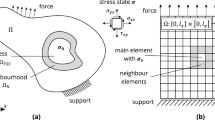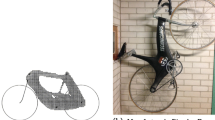Abstract
In industry, some parts are prone to failures or their design is simply sub-optimal. In those critical situations, one would like to be able to make changes to the part, making it lighter or improving its mechanical resistance. The problem of as-built parts is that the original computer-aided design (CAD) model is not available or is lost. To optimize them, a reverse engineering process is necessary to capture the shape and topology of the original design. This paper describes how to capture the original design geometry using a semi-automated reverse engineering process based on measurement provided by an optical 3D sensor. Following this reverse engineering process, a Fixed Grid Finite Element method and evolutionary algorithms are used to find the optimum shape that will minimize stress and weight. Several examples of industrial parts are presented. These examples show the advantages and disadvantages of the proposed method in an industrial scenario.
Similar content being viewed by others
References
Annicchiarico W, Cerrolaza M (2004) A 3-D boundary element optimization approach based on genetic algorithms and surface modelings. Eng Anal Bound Elem 28:1351–1361
Bäck T (1996) Evolutionary algorithms in theory and practice. Oxford University Pres, New York
Bäck T, Schwefel HP (1996) Evolutionary computation: an overview. In: IEEE International conference on evolutionary computation, Nagoya, Japan, pp 20–29
Besl P, McKay N (1992) A method for registration of 3-D shapes. IEEE Trans Pattern Anal Mach 14(2):239–256
Garcia M, Henao M, Ruiz O (2005) Fixed grid finite element analysis for 3D structural problems. Int J Comput Methods 2(4):569–586
García M, Henao M, Boulanger P (2007) Evolutionary algorithms applied to shape optimisation of 3-d structures. Int J Struct Multidiscip Optim (in press)
García M, Gonzalez C (2004) Shape optimisation of continuum structures via evolution strategies and fixed grid finite element analysis. Struct Multidisc Optim 26(1–2):92–98
García M, Steven GP (1999) Fixed grid finite elements in elasticity problems. Eng Comput 16(2):145–164
García MAH (2005) Evolutionary algorithms applied to shape optimisation of 3-D structures. Final year project, Mechanical Engineering, EAFIT University
Gen M, Cheng R (1997) Genetic algorithms and engineering design. Wiley, New York
Haftka R, Gurdal Z (1992) Elements of structural optimization, 3rd edn. Kluwer, Norwell, MA
Levenberg K (1944) A method for the solution of certain problems in least squares. Q Appl Math 2:64–168
Piegl L, Tiller W (1997) The NURBS book, 2nd edn. Springer, Berlin
PTC (1997) Pro/Toolkit reference manual. Parametric Technologies, Waltham, MA
Saitou K, Izui K, Nishiwaki S, Papalambros P (2005) A survey of structural optimization in mechanical product development. J Comput Inf Sci Eng 5:214–226
Schwefel HP, Rudolph G, Bäck T (1995) Contemporary evolution strategies. In: European conference on artificial life, Granada, Spain, pp 893–907
Sobieszczanski-Sobieski J, Haftka RT (1996) Multidisciplinary aerospace design optimization: survey of recent developments. citeseer.ist.psu.edu/sobieszczanski-sobie96multidisciplinary.html
Spath D, Neithardt W, Bangert C (2002) Optimized design with topology and shape optimization. Proceedings of the Institution of Mechanical Engineers, part B. Eng Manuf 216(8):1187
Woon SY, Querin OM, Steven GP (2000) Application of the fixed-grid FEA method to step-wise ga shape optimisation. In: Engineering design optimization. Proceedings of the second ASMO–UK /ISSMO conference, Swansea, UK, pp 265–272
Author information
Authors and Affiliations
Corresponding author
Rights and permissions
About this article
Cite this article
García, M.J., Boulanger, P. & Henao, M. Structural optimization of as-built parts using reverse engineering and evolution strategies. Struct Multidisc Optim 35, 541–550 (2008). https://doi.org/10.1007/s00158-007-0122-6
Received:
Revised:
Accepted:
Published:
Issue Date:
DOI: https://doi.org/10.1007/s00158-007-0122-6




